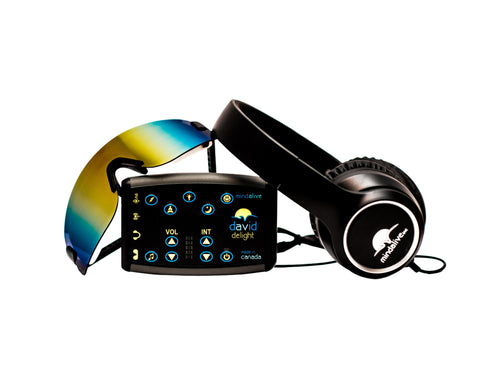by Dave Siever, Nov 2022
Back around 2000, we recognized some clinical limitations with Audio-Visual Entrainment (AVE). Using fixed-frequency protocols, we had 40 sessions available in the Paradise device model that we were building at the time. Despite having so many protocols, our customers still wanted more, because the difference of a simple 0.3 Hz change in frequency could produce clinical effects in either positive or negative ways. Then there was the added problem of trying to find the appropriate session. Sometimes, that could take a few weeks of trial and error before we found the “right” session. So, we introduced the ability to stimulate at one frequency on the left side and a different frequency on the right side.
We also knew that dissociation was an essential part of a beneficial AVE experience. With this dual-frequency system we experimented with a 0.3 - 0.5 Hz difference between the left and right sides and found that to be beneficial, especially for ADHD children and people struggling with anxiety, cognitive over-arousal, and depression. Interestingly, some clinicians were experimenting with this at the same time. When I reported on this new development to Michael Joyce, neuroscience director at A Chance to Grow, a school for children with developmental delays, Michael confided that he was already doing this with improved results. So, it seemed that complex stimulation was more effective than fixed stimulation. Then, I got involved with a team of psychologists to try out, not just complex stimulation, but randomized-complex stimulation – and the results were impressive. We all gathered metrics from our clients and pooled the results. We discovered that randomizing the stimulation was more effective! So, we determined that entrainment in the classical sense of driving brain waves was not everything that was happening. Other things were going on.
In the past, we always tried to differentiate our scientifically proven concept of entrainment to what many other manufacturers were doing - simply presenting flashing lights and tones which I referred to as audio-visual stimulation (AVS). We experimented with varying amounts of randomization. Watching a TV is a form of AVS – which has never proven itself to enhance brain function. Throughout the past 20 years, when a client complained that their AVE session wasn’t working, I have on occasion replaced the built-in fixed frequency session with a randomized one and over 20 years, the metrics supported this idea. Most of our current protocols continue to have a fixed frequency portion to them, but all of our sessions, (with exception of the eyes-open reading protocol) utilize randomization throughout a portion of the session.
Differences Between AVE and AVS
1) Watching a TV is AVS with no clinical value.
2) Fixed AVE shows fairly good clinical value.
3) Randomizing AVE by 1 Hz shows the best clinical value.
4) Randomizing AVE by 2 Hz shows about the same clinical value as fixed frequency stimulation.
5) Randomizing AVE by 3 Hz shows poor clinical value.
So, randomized AVE is a good thing to have for the best results. In fact, we are RAVING about it! Our randomized process doesn’t simply change the frequency, but it changes the frequency of both left and right sides independently of each other and the time at which these changes come about is also randomized, making for wonderfully complex stimulation. Every time a session is played, the randomization is different.
We have also discovered over the years, that there are other effects happening when using RAVE:
1) EEG frequency changes.
2) Dissociation in a meditative way that breaks the HPA (or fight-or-flight axis) which has an instant calming effect.
3) Increased cerebral blood flow.
4) Increased beneficial neurotransmitters such as serotonin, endorphins, and mild increases in norepinephrine.
5) Increased ATP and lactate.
6) Increased heat-shock protein.
7) Increased non-inflammatory cytokines.
When the frequency-following-response was discovered by Adrian & Matthews in 1934, only the frequency-following aspect of entrainment was known. So, for the next 50 years everyone thought that frequency was the be-all and end-all to AVE. From the list above, we can see that the frequency part of entrainment is only a small part of the picture. Much bigger things are going on. For instance, for very agitated persons, alpha frequency stimulation may actually increase their agitation and anxiety. However, randomized entrainment (RAVE) with two frequencies, or in the SMR band might knock them right out into a deep alpha and even a theta mind state.
Of course, I’ve been lecturing for years that those struggling with a post-inflammatory thalamocortical disconnect from concussion or viral infection cannot make alpha brain waves. And so they have intense anxiety, often using alcohol and marijuana to calm themselves. Alpha AVE stimulation does not help them make alpha. But SMR/Beta RAVE will often fire up large amounts of alpha within 20 minutes.
As we established already, fixed-frequency AVE certainly helps with cognition in college students and seniors, but RAVE is somewhat better. See the three charts below.



The improvements using RAVE with ADHD are quite striking. This chart below shows the difference between a child that resists even sitting for an AVE session and a child that drifts into a peaceful trance and enjoys the RAVE process, thus being compliant with the therapy.

It is clear that Randomized AVE is very valuable and has helped make audio/visual stimulation so much more effective for many more people.
